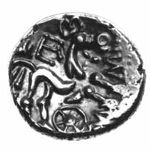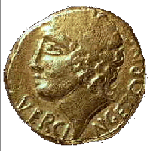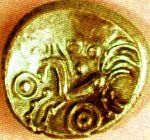A whole week has passed in which I have been very busy, but somehow I don't recall accomplishing anything :/. It suddenly struck me that I hadn't done any pictures for War in Gaul for a while, and my fingers got itchy... So here is a sketchdump with the results.

Here is a first glimpse of my Original Roman Character (*grin*), Quintus Tullius Veridicus. At this stage he is still worryingly much "a Roman" - that is, I know quite a few things about him, but not so much his looks, unfortunately. Amateurs of Roman names may notice that Veridicus has Etruscan ancestors: the Gens Tullia, so I discovered, has Etruscan roots, and the name "Quintus" is not the Latin for "fifth", but a Latinised form of the Etruscan name "Cuinte".
The reason why I am so keen on making this man Etruscan is because - well, there are several things. First off, the Etruscans made the Romans, but sort of disappeared inside them as well. I find that an interesting given. Second, the kings of pre-Republican Rome were Etruscans. They were so hated that they inspired fear of kingship in ancient Rome, and one reason why a civil war broke out between Caesar and Pompey is that many people feared that Caesar wished to turn Rome into a monarchy again. (They were right, of course, and le grand Jules ended up being stabbed to death by a bunch of Republicans.) I like to refer to this conflict between republicans and monarchists because what Vercingetorix tried to achieve in Gaul effectively mirrors Caesar's actions in Rome. I'm not sure yet how I am going to integrate this into the narrative, but at least the element will be there so that I can call upon it when it pleases me :-).
Finding a face for Veridicus is not so easy. I should like to have a look at the ancient paintings in Etruscan tombs, to see if I can snatch some stereotyped looks of the people depicted there... One problem I have is that the Romans don't seem to leave me a lot of scope in terms of hairstyle to help me distinguish between characters :/. I am at present in danger of producing a bunch of clones...
I have also been pondering Veridicus's cognomen. I don't know of any Romans called Veridicus. I gave him that name as a cognomen in the sense of a nickname that says something about the kind of person he is (in this case, "he who tells the truth", honest and outspoken), but in fact I doubt that the cognomen still functioned that way in the first century BC. It is rather likely that he would have a more standardised name, one that serves to specify the specific branch of the Tullia family from which he hails. Of course in the meantime I have become rather attached to the name of Veridicus, and I'd rather not change it. And I don't know how many people would fuss about it if I let it stand ;-).

I am still working on Rigantona. It is such a bother having to draw someone really pretty. I mean, I hate it when I read a comic where it is clear that a character is supposed to be gorgeous when they don't look at all gorgeous to me. Besides, it really annoys me when an artist can't draw beautiful women. So, well, I would rather not be guilty of those offenses myself XD.
It's a bit stupid - I used to be much better at drawing pretty girls than at drawing men. Then I tried to get better at drawing men, and now I am no longer happy with how my women look (and my men still look girly *g*). Blah.
Anyway - Riga is improving, I am glad to say, though there is still some work to be done. I guess I will be looking at photos of beautiful women for inspiration, and see where it takes me. I also need to go back to studying naked females. Something always seems to goes wrong with the ladies' boobs these days, and we can't have that, can we? Not that you should ever expect the trashy Lady in Skimpy Outfit from me, but I want to be able to do "alluring" when I need it :-). I'll post the results as soon as they look nice.
It's a bit stupid - I used to be much better at drawing pretty girls than at drawing men. Then I tried to get better at drawing men, and now I am no longer happy with how my women look (and my men still look girly *g*). Blah.
Anyway - Riga is improving, I am glad to say, though there is still some work to be done. I guess I will be looking at photos of beautiful women for inspiration, and see where it takes me. I also need to go back to studying naked females. Something always seems to goes wrong with the ladies' boobs these days, and we can't have that, can we? Not that you should ever expect the trashy Lady in Skimpy Outfit from me, but I want to be able to do "alluring" when I need it :-). I'll post the results as soon as they look nice.

This is slightly more serious as a drawing :-). A few weeks ago now I thought I'd take out the enormous pencil set which Waterzooi gave me as a present this summer, and see where all those types of graphite would lead me. I was thinking of a picture I had done of Volca a while ago, and of the nice effect I got doing the texture of her skirt - I wanted to have a try with Comm and exercise my cross-hatching skills. It didn't work very well at first, but I continued to layer with ever darker pencils until the hood looked really nice (or so I think). What keeps escaping me is the shading of faces. I really didn't like what I got, and erased almost all of the work I did on the face. In the end I have a relatively realistic hood and beard, combined with my typical cartoony face. I'm not sure whether I am entirely happy with that.
What I do like is the fibula :-). If you click the picture and zoom, you'll get a better idea of what I mean: the hard pencils allowed me to achieve what for me is a rather good metal-y look *g*.
What I do like is the fibula :-). If you click the picture and zoom, you'll get a better idea of what I mean: the hard pencils allowed me to achieve what for me is a rather good metal-y look *g*.
 Seriouser and seriouser: the following is a quick sketch run riot :P. I was drawing spears in the booklet that I keep for copying historical artefacts, when something struck me about the designs I was drawing, and I ended up toying with a bit of plot. To make sure that I wouldn't forget it, I doodled a scene, and then thought I might as well refine the drawing, and everything got out of hand from there *g*.
Seriouser and seriouser: the following is a quick sketch run riot :P. I was drawing spears in the booklet that I keep for copying historical artefacts, when something struck me about the designs I was drawing, and I ended up toying with a bit of plot. To make sure that I wouldn't forget it, I doodled a scene, and then thought I might as well refine the drawing, and everything got out of hand from there *g*.Yes, yes, plenty is wrong with this, but please have mercy and don't tell me right now - you can offer concrit in a few days, when I am ready to accept enumerations of all the flaws. It will be obvious that I didn't use reference for anything except the spear and the Roman uniform, and then I didn't even check whether I gave Veridicus the clothes that befit an eques... I was enjoying myself too much to bother. Bad reflex, that ;-).
So, anyway: here are Veridicus (looking rather "standard Roman" - *sigh*) and Comm, in a picture entitled, Comm Commios and the Well-Ordered Mind. *giggles*
There is a story to go with it - though, story... It's horrible, but I will always drift from action into contemplation, it seems. I'm supposed to be working about the war in Gaul, so you'd expect plenty of action, but what do I get? "We interrupt the action for a Philosophical Interlude about the Difference between Roman and Celtic Mindsets." Go me. Alas, this is my idea of "fun" and "interesting stuff". Incidentally, this drawing has decided for me that Veridicus and Comm will meet - they weren't going to. I had invented Veridicus for another storyline. But Comm is the kind of character who wants to understand what makes Romans tick, and that means he needs a Roman willing to talk to him about such things. Caesar would seem too busy, Antonius too frivolous, Labienus too antagonistic - so I thought of Veridicus. I will have to find out which rank and function he needs to have in order to hang around Comm for a while and then move somewhere else when I want him to.
The drawing doesn't really work without a plot - it doesn't tell you by itself why Comm looks so startled, or what Veridicus is talking about. But I like it because I ended up making it very detailed in terms of costumes and such. In fact, when I was done with the pencils, I thought it might be worthwhile to try and colour the drawing, because it would provide a good picture of the complete look I hope to achieve. I'm not saying that it's now decided that everything will look like this - just that graphite and black/white feel incomplete for this project, and that I want to get an idea of what a coloured look can be like.
I didn't want to colour my pencils, because they were too small. I photocopied the drawing from my sketchbook onto heavy paper, enlarging it to twice the original size. The photocopier didn't like my paper, and its black dusty stuff stained and came off. The photocopy looked very grotty, which normally speaking I would hate, but somehow I took a fancy to all the dust and stains and decided to use it. The photocopy dust mixed with my coloured pencils, but I thought that made for a nice effect. I guess the result is my best pencil colouring job to date, and at this moment I am rather pleased with it ;-).
It was more obvious to me in the pencil version that Veridicus is looking at the tip of the spear, not at Comm - in the "inked" version he seems to be staring at a point between Comm's head and the spear tip. Too bad. At least I had fun with it, and Comm looks singularly handsome ;-).



































